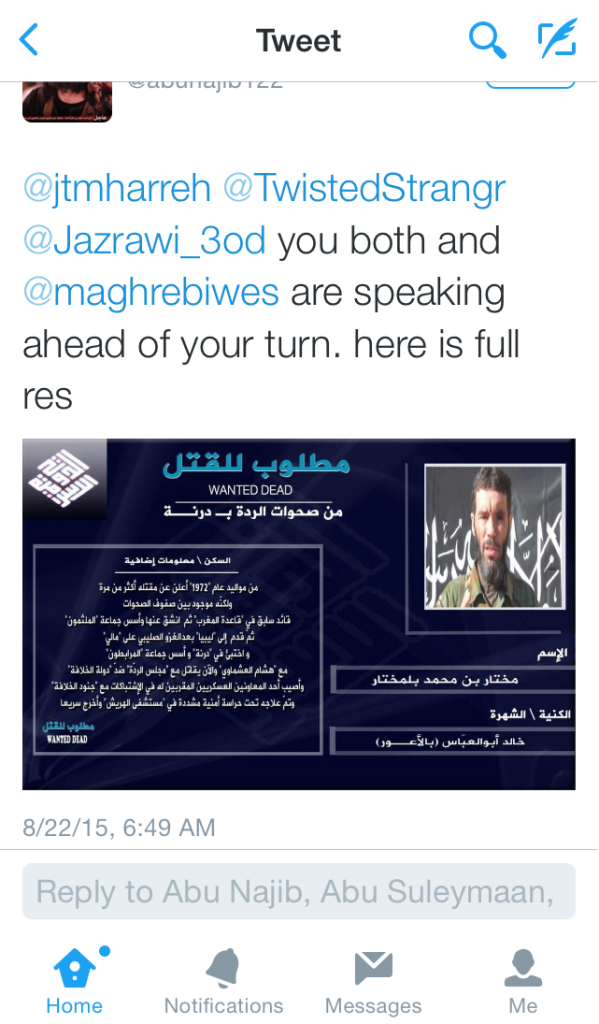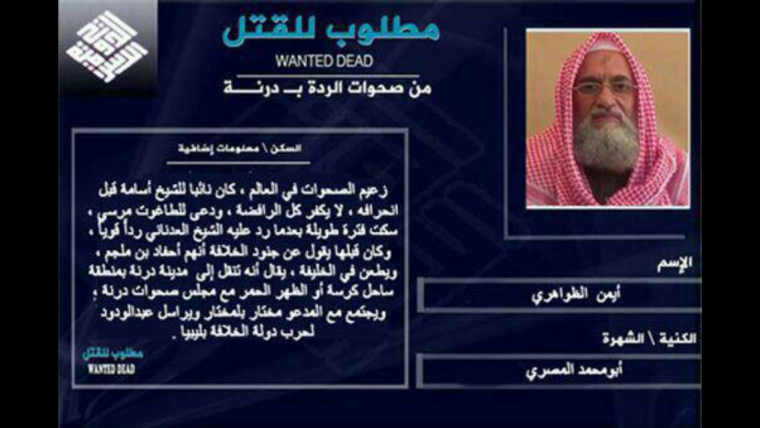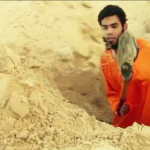ON THE ZAWAHIRI ‘WANTED DEAD’ POSTER AND OTHER MATTERS
ON THE ZAWAHIRI ‘WANTED DEAD’ POSTER AND OTHER MATTERS
By Michael S. Smith II
Programming Note: The DOWNRANGE team has been busy tending to other efforts. We hope to resume regular reporting in mid-September.
On 23 August 2015, Twitter accounts used to promote DA’ISH propaganda were observed distributing a “Wanted Dead” poster featuring a photo and information about al-Qa’ida’s current leader, Ayman al-Zawahiri (see lead image). The DOWNRANGE team observed the poster being distributed via Twitter a day after a similar poster featuring information about Mokhtar Belmokhtar was distributed by DA’ISH propagandists (screenshot below). Days earlier, DA’ISH distributed other “Wanted Dead” posters featuring information about other non-DA’ISH aligned terrorists believed to be operating in and around Libya. Also in recent days, possibly to further antagonize al-Qa’ida-affiliated elements in Libya, DA’ISH supporters have been observed tweeting about a rumor that Wissam bin Hamid, a high-profile Ansar al-Sharia commander, has joined DA’ISH.

The image of al-Zawahiri used in the “Wanted Dead” poster appears to be a screenshot produced by an observer of al-Qa’ida’s seventh installment of its “Days with the Imam” video series. Below are screenshots produced by the DOWNRANGE team while observing the film.

The seventh installment of the commemorative series about the life of Usama bin Ladin, as told by al-Zawahiri, was released by al-Qa’ida’s as-Sahab media wing earlier in August 2015. Links to the video were distributed via Twitter soon after the release of the first public message from al-Zawahiri in more than a year.
In the first of these recently-released public messages from al-Zawahiri, al-Qa’ida’s leader pledged bayat to the new leader of the Afghan Taliban, Mullah Akhtar Mansour. Bayat is a religiously-binding oath of allegiance that, in this context, is used to define hierarchical features of jihadist groups and networks. Specifically, following a model established by the first generations of Muslims, it is used to define leadership positions.
As was the case with Mullah Omar, jihadist icons are referring to the new leader of the Afghan Taliban using a title historically reserved for the caliph, Emir al-Mu’minin (Commander of the Faithful). And like his predecessor Usama bin Ladin, Ayman al-Zawahiri has subordinated al-Qa’ida to the Afghan Taliban.
In fact, this is the second time al-Zawahiri has subordinated al-Qa’ida to the Taliban. As he noted in a September 2013 address, “How can anyone accusing us of claiming to be the caliphs of Muslims forget that we have pledged allegiance to the Emir of the Believers Mullah Mohamed Omar Mujahid, may God protect him, and that he is the emir of the Islamic Emirate of Afghanistan.” Later, following Abu Bakr al-Baghdadi’s assumption of the title of caliph and his group’s corresponding demands that all jihadis pledge bayat him, al-Qa’ida leaders repeatedly rebuffed DA’ISH’s claims and demands by noting they had pledged bayat to Mullah Omar. In effect, al-Zawahiri and others were saying, the only way we may pledge bayat to al-Baghdadi is if Omar were to recognize him as the caliph. However, that would have been impossible, as Omar died in a hospital in Pakistan more than a year before DA’ISH declared the establishment of its so-called caliphate.
That al-Qa’ida’s leaders and their mouthpieces like Jordanian cleric Mohamed al-Maqdisi made it a protocol to use the title Emir al-Mu’minin when referring to Omar is a strong indication these jihadis viewed Omar as a caliph. This, while viewing al-Qa’ida and affiliated groups as an army which, according to their interpretations of Hadith, would march forth from the Khorasan region to assert Islam’s primacy on a global scale.
Indeed, in April 1996, when Omar made a rare public appearance in order for religious leaders to confer upon him the title of Emir al-Mu’minin, he wore the “cloak of the prophet,” a religious relic that had been stored in Kandahar. Further, as highlighted in a video of bin Ladin discussing his pledge of bayat to Omar that was distributed by al-Qa’ida to rebuff DA’ISH’s claim that al-Qa’ida members and other jihadis should pledge bayat to al-Baghdadi, bin Ladin argued that the fact Omar was not descended from the same tribe as the founder of Islam did not disqualify Omar from being recognized as the caliph. This, despite history suggesting otherwise. Further, bin Ladin noted his pledge of bayat to Omar was the very pledge historically given by Muslims to the leader, or caliph, of Islam.
Earlier in August 2015, Mansour accepted al-Zawahiri’s pledge of allegiance, along with the publicly-announced pledges of bayat issued by other leaders of jihadist groups. Like al-Qa’ida, a number of those groups are designated foreign terrorist organizations (FTO) by the US State Department. Meaning that the Afghan Taliban — with its various subordinated groups that are designated FTOs by the US State Department — fits the US State Department’s definition of an FTO.
It is not a coincidence that DA’ISH has distributed a “Wanted Dead” poster featuring information about al-Zawahiri just after al-Qa’ida’s leader pledged bayat to the new leader of the Afghan Taliban. Further, it would be unsurprising if DA’ISH were to next issue a “Wanted Dead” poster featuring information about Mansour. Not only is al-Zawahiri’s pledge of bayat to Mansour meant to undermine al-Baghdadi; so too is Mansour’s acceptance of the oaths of allegiance sworn to him by al-Zawahiri and other prominent terrorists.
Meanwhile, it is unclear if al-Zawahiri has broken his silence simply because of the leadership change that has now publicly taken place within the Afghan Taliban.
A year ago, a reliable source advised that al-Zawahiri had been living under the watchful eyes of Pakistan’s Inter-Services Intelligence (ISI) in Rawalpindi. Accordingly, ISI wished to move al-Zawahiri out of Pakistan due to fears of what might ensue if another al-Qa’ida leader were to end up dead in Pakistan — even if by natural causes.
So perhaps the return to the airways of al-Qa’ida’s verbose second emir is meant as a reassurance to his subordinates that he is still alive. And perhaps his change of attire and the change of backdrop for the video’s shoot are meant to serve as signals that al-Zawahiri has changed addresses. Indeed, perhaps — like so many of bin Ladin’s immediate relatives who are now living in a government-subsidized compound in Qatar — al-Zawahiri made his way to the Gulf region.
And perhaps, as the group is likely trying to do with its “Wanted Dead” posters featuring information about various jihadi figures, DA’ISH will deliver the US information that may be used to locate al-Zawahiri. As noted here at DOWNRANGE in July 2014: “al-Qa’ida’s and IS’s ostensibly competing efforts to unify the ummah through the reestablishment of a caliphate appear to be yielding far more discord than harmony within the Global Jihad movement. Taking into consideration this state of affairs, for terrorism analysts concerned with identifying exploitable tensions within this movement it seems the fruit has rarely hung so low.”




